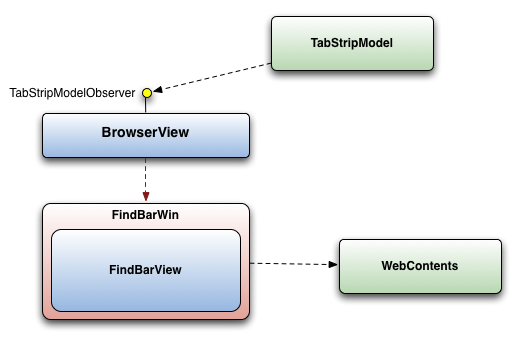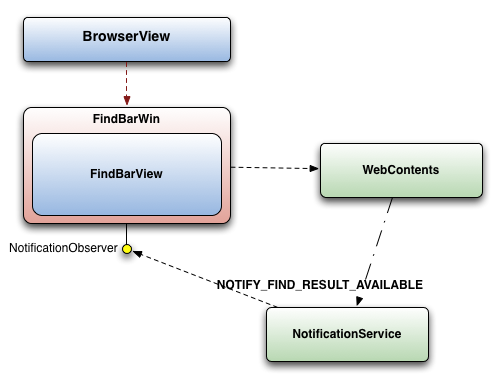Find Bar
Background
Google Chrome implements find for web pages using a "Find Bar" which appears from the top right (or top left, depending on language) corner of the browser window. The bar contains a text field for typing in search terms and some controls for advancing find selection and closing the bar.
This is a proposal for lifetime management of the Find Bar. At present, the Find Bar is created and owned by the WebContentsViewWin, and a unique one is maintained per Tab. The FindBar is implemented as a WidgetWin subclass called FindBarWin, which is a WS_CHILD of the frame. Whenever the selected tab changes, if the newly selected Tab has a FindBar, it is made visible. Whenever a tab is dragged out of a window and into another, the FindBarWin associated with that Tab is re-parented to the new window.
To increase the flexibility of the TabContents/WebContents API and to enhance the consistency in how bits of Chrome browser UI are maintained, we have been moving the creation and ownership of bits of the Chrome browser UI out of the TabContents and other objects and into the BrowserView. (This has already been completed for the TabStrip, the browser toolbar, InfoBars, and some other objects). The BrowserView class has become the class that represents the contents of the window independent of frame type. For more information on this read the Browser Window document. The general intent of this design approach is that the "View" in the MVC sense (the hierarchy of objects implementing the BrowserWindow interface) is able to initialize its state from the set of Model objects that back it, (Browser, TabStripModel, TabContents, etc).
New FindBar Creation and Ownership
In light of this transition, it made sense that the Find Bar, as a part of the Chrome Browser UI, be created and managed with the rest of the Browser UI. The logical place for this is the BrowserView class, which creates and lays out the toolbars, info bars, and other elements of the Browser Window. In this new world, an instance of the FindBarWin class is created for every BrowserView at the time it is added to the frame's Widget, and is maintained for the lifetime of that BrowserView.
The WebContents object is extended to provide a basic interface for finding (that drives the underlying RenderViewHost and WebKit) and also carries some state about the last search string the user entered, whether a find session is currently active for the tab, and the last set of Find results that were returned from WebKit (in the form of a FindNotificationDetails object held as a member variable).

The BrowserView implements the TabStripModelObserver interface, and so is notified of tab switches, additions and removals. Whenever the selected tab changes, the BrowserView tells its FindBarWin to change the WebContents it's active for (if the newly selected Tab is a WebContents). FindBarWin code initializes its UI from the state of the newly set WebContents so that the View is brought up to date with the Model.
When it comes time to perform a find, the FindBar code (in FindBarWin and FindBarView) drives the WebContents it is attached to directly by starting a find session. The WebContents implements the RenderViewHostDelegate interface which includes an OnFindReply method which is called when the renderer process returns with find results. WebContents updates its last saved results and then notifies interested observers via the NOTIFY_FIND_RESULT_AVAILABLE notification:

The FindBarWin then updates its contained view (FindBarView) with the current result values from the WebContents. This change means that both the UI and the automation provider (used for UI tests for Find in Page) obtain their state from the same notification.
Layout
The Find Bar is always positioned attached to the lowest row in the "visible toolbar" of the Browser window. This means the Bookmark Bar if the Bookmark Bar is persistently visible across tabs, or the main toolbar if the Bookmark Bar is not persistently visible across tabs. This requires some work in Find Bar's positioning logic to identify the state of the parent BrowserView so it can position itself appropriately. With the old design, this was harder because the FindBarWin object didn't have direct access to the BrowserView so had to do a lot of work to figure out the bounds of various elements of the Browser UI and position relative to them. With the new design, there is a direct 1:1 mapping between the FindBarWin and its parent BrowserView. The BrowserView does Layout for all of its child views (including the toolbars the FindBarWin must layout relative to) and so under the new design the FindBarWin can just ask the BrowserView what its bounding box should be.
Tab Drag & Drop
When a Tab is detached from one window and dropped into a different one, a few things happen. In both the source and the target windows, a different tab is selected. In the source window, another tab becomes active and the Find Bar for that window is updated with the state of that tab, which might not have a find session active in which case it'll be hidden. In the target window, the dragged tab will cause that window's find bar to be initialized with the state of the tab that was inserted and selected. Native child windows are never reparented (and thus there are no focus manager transitions) under this design.
Prepopulate State
When the Find Bar appears, it is pre-filled with the string that was searched for last in that Tab. If there is no previous text the Find Bar shows no string. The ownership changes described here do not affect this behavior - every WebContents maintains a new find_text_ member that tracks the last text the user searched for. In the future, we want to change this such that if there is no last find string for a specific tab but there is for another tab, then we populate with that string instead. This proposal does not affect this behavior at this time however.
Long Running Find Queries
Find queries in long documents can take some time to execute. Handling the results from a find operation is contained entirely at the WebContents level. When a query is initiated from a particular WebContents that WebContents receives its results. When the WebContents receives the results it notifies interested observers, which may include the Find Bar UI, if that Tab is active. When the selected tab changes, the Find Bar code un-registers itself as an observer of find result notifications sourced from the last selected WebContents and registers itself as an observer of find result notification sourced from the new one. This ensures that the Find Bar only receives update notifications from the selected WebContents, even if a find operation is pending in multiple tabs. When the user switches back to another tab, the Find Bar will be initialized with the current result state of that tab and observe any future results in it for as long as that tab remains selected.